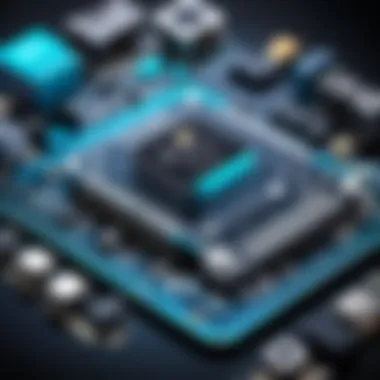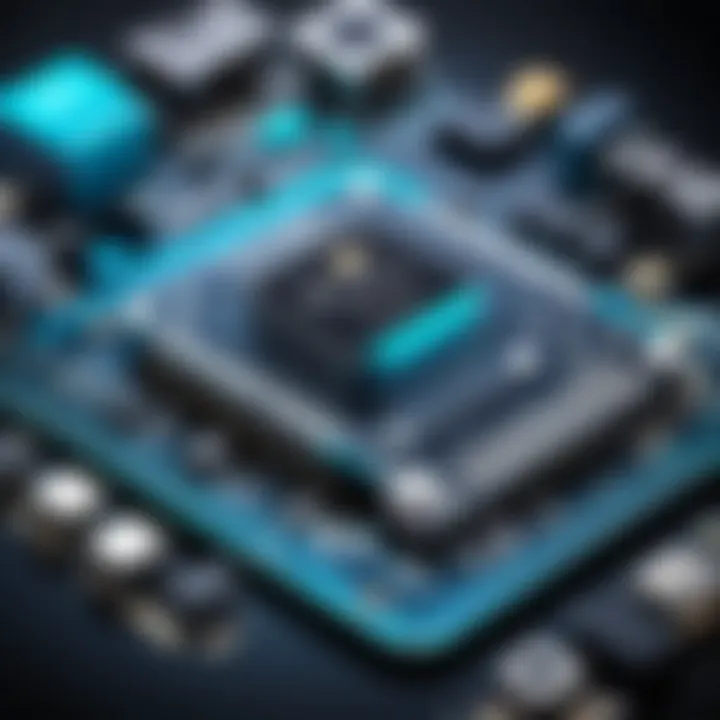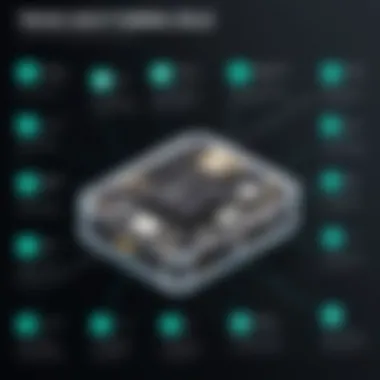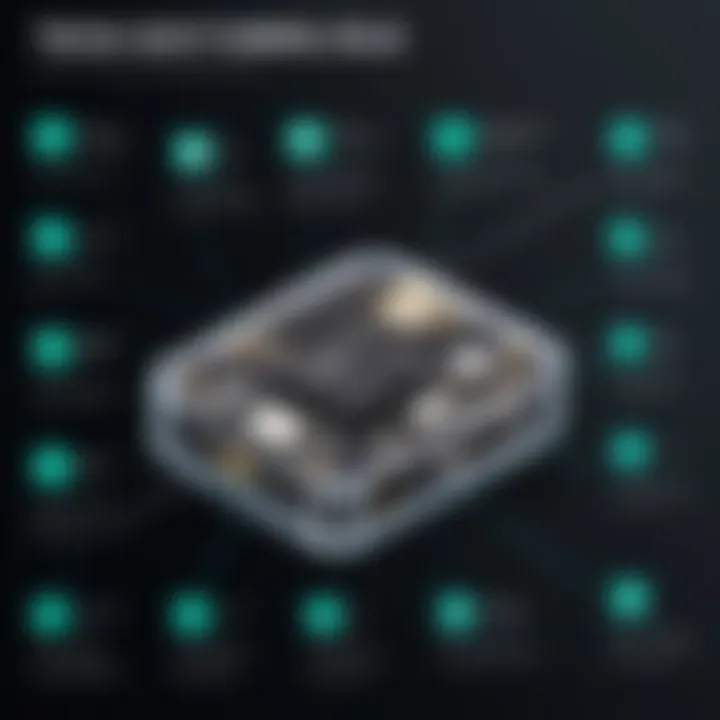Unlocking Potential with Blynk IoT: A Professional Guide


Intro
In the realm of the Internet of Things (IoT), efficient management of numerous interconnected devices remains a pressing challenge. As businesses integrate IoT solutions, platforms like Blynk IoT offer innovative approaches to facilitate these connections. This guide will explore Blynk IoT in detail, assessing its utility among professionals and within various industries.
Understanding how Blynk IoT operates is vital for decision-makers and IT professionals looking to optimize project workflows. The following sections provide a detailed overview, examining both Blynk's architecture and its practical applications across different market segments.
Key points of discussion will include the current trends within the IoT software landscape, emerging technologies that drive development, and factors professionals should consider when selecting and implementing software solutions like Blynk IoT. By synthesizing the vast array of information on this platform, this guide aims to empower users to leverage IoT solutions effectively.
Industry Overview
In recent years, the IoT industry has seen exponential growth. Market demand has spurred extensive advancements in technology. Five billion IoT devices were deployed in homes and businesses, measuring diverse metrics from energy transfer to vehicle location.
Current Trends in the Industry-specific Software Market
- Increased Focus on Data Security: With the growing number of devices connected to the internet, security has become a primary concern. Security frameworks have started to incorporate advanced encryption and thorough risk assessments to safeguard signaling.
- Advent of AI and Machine Learning: The integration of artificial intelligence-powered algorithms with IoT platforms enables real-time data processing, making results insightful and actionable.
- Emphasis on Interoperability: Companies search for solutions that allow different devices and platforms to communicate effectively.
Key Challenges Faced by Buyers in the Industry
Deciding on a suitable IoT platform is crucial. However, professionals often encounter several challenges:
- Complexity in integrating various devices
- The difficulty in identifying suitable vendors
- Balancing costs while upholding quality
Emerging Technologies Impacting the Industry
Innovations such as edge computing and blockchain technology are fostering new opportunities.
- Edge Computing: Offers low-latency data processing at the source rather than relying heavily on the cloud.
- Blockchain: Enhances security measures and augments trust in transactions between devices.
Top Software Options
Blynk IoT stands among several leading software providers in the marketplace. The next section compares features amongst various platforms, including notable alternatives to Blynk.
Review of Leading Software Providers in the Industry
Blynk IoT effectively connects devices while allowing user-friendly configuration. AWS IoT Core offers a broader cloud service integration, suitable for large-scale environments. Microsoft Azure IoT Suite provides insightful machine learning capabilities for data analysis.
Feature Comparison of Top Software Solutions
| Feature | Blynk IoT | AWS IoT Core | Microsoft Azure IoT Suite | | Device Management | Easy to use | Complex | Integrated | | Data Security | High | High | Very High | | Supports Protocols | MQTT, HTTP | MQTT, WebSocket | MQTT, HTTPS |
Pricing Structures of Different Software Options
Pricing models vary significantly among suppliers, influenced by the built-in offerings, scalability, and support:
- Blynk IoT charges $29 monthly for the basic tier.
- AWS IoT Core generally divides by $1 for every 1 million messages.
- Azure IoT Suite leans towards a base fee structure combined with usage-based costs.
Selection Criteria
When determining which IoT platform to implement:
Important Factors to Consider When Choosing Software
- Compatibility with existing systems
- Scalability potential to grow with the business
- Customer support responsiveness
Common Mistakes to Avoid During the Selection Process
- Underestimating the total cost of ownership
- Ignoring vendor reliability and service history
- Selecting a solution without conducting ample testing beforehand
How to Determine the Right Fit for Your Business Needs
Review the goal of the IoT implementation clearly. Retrieves proper specifications and ensure evaluated platforms align with long-term objectives.
Implementation Strategies
It’s crucial to manage deployment efficiently. Strategies arise based on sector needs proposed.
Best Practices for Smooth Implementation of Software Solutions
- Committed LeadershipBlynk; advocated freuent reviews throughout the process.
- Pilot Testing Run test cases to identify potential influences well-before full-scale deployments.
Integration with Existing Systems and Processes
Aid integration by reviewing APIs and potential restrictions posted by current technologies.
Training and Support Resources for Successful Deployment
Since most IoT platforms demands adept understanding, organized training enables effective adaption among users, minimizing project downtime.
Future Trends
The horizons of the IoT landscape are ever-changing. Understanding these developments can devised insights for competitive advantage.
Predictions for the Future of the Software Landscape


Growing reliance on platforms like Blynk suggests mainstream adoption. Small and medium businesses have finally acknowledged the utility.
Upcoming Technologies Shaping the Industry
Continued use of machine learning and data analyses frameworks will propel advancements made in IoT verticals.
Recommendations for Future-Proofing Your Technology Stack
Avoid obsolescence by committing to flexible and reliable platforms that entertain updates to integrate future enhancements as trend elevate.
Cross-reference with reputable sources for insights on collaboration technologies such as access comparisons to emerging tools. Visit Wikipedia, Britannica, or online forums like Reddit.
Foreword to Blynk IoT
The introduction to Blynk IoT plays a significant role in understanding its overall impact on the realm of Internet of Things (IoT) projects. As an effective platform, Blynk bridges the often complex gap between hardware and software, expertly simplifying the connection for developers and professionals. This segment articulates what Blynk IoT is and highlights its importance in the contemporary technological landscape.
What is Blynk IoT?
Blynk IoT is a versatile platform designed for creating IoT solutions. It provides tools necessary for managing and processing the data generated from interconnected devices. The platform supports various types of users, ranging from experienced developers to those just beginning their journey in IoT.
At its core, Blynk IoT offers a user-friendly interface and libraries that facilitate easy integration with numerous hardware components. Additionally, its revolutionary dashboard allows for real-time data visualization, improving the user experience significantly. This flexibility allows Blynk IoT to support a wide array of applications, from home automation systems to industrial solutions.
Importance of IoT in Modern Technology
Understanding the significance of IoT technologies is essential for any professional adamant on improving operational efficiencies and driving innovation. IoT connects various devices to the Internet, allowing them to communicate and share data automatically. This integration isn't just about convenience; it propels significant advancements across many sectors.
Among the benefits of IoT incorporation are:
- Enhanced Efficiency: Alleviating the need for manual operations in industries decreases labor costs and reduces errors.
- Data-Driven Decisions: Accumulated real-time data allows organizations to make informed strategic decisions quickly.
- Automation and Control: IoT fosters the automation of functions, empowering users to control devices remotely.
- Sustainability: Efficient resource management and energy consumption can contribute to environmental sustainability.
Core Features of Blynk
In the realm of Internet of Things solutions, the core features of Blynk Iot stand out as pivotal elements for professionals and decision-makers. The effectiveness of any IoT platform is often catalyzed by its core features, which directly impact user experience, functionality, and overall project efficiency. Therefore, understanding these features is crucial for leveraging Blynk’s full potential in designing, deploying, and managing IoT projects.
User-Friendly Interface
One of the primary distinguishing factors of Blynk IoT is its user-friendly interface. It plays a significant role in ensuring that users can navigate the platform with ease. For professionals with varying degrees of technical proficiency, the intuitiveness of the UI facilitates a quicker learning curve.
This interface allows users to create applications without needing extensive coding skills, using visual programming. The drag-and-drop function for widgets simplifies the design process. Therefore, even those who might otherwise be intimidated by IoT technology can utilize the platform.
Key Benefits
- Familiar layout: Adopts common design principles, making transitions easy for users.
- Streamlined onboarding process: Users can start quickly, reducing downtime.
Customizable Dashboards
Blynk IoT allows users to design and customize dashboards tailored to their project's specific needs. This feature is particularly significant for professionals because tailored visualization can enhance data interpretation. A personalized dashboard can display relevant data and insights, ensuring critical parameters are monitored efficiently.
The monitoring requirements often differ per project. For example, certain industries may prioritize energy consumption metrics, while others might focus on operational efficiency. Therefore, having the capacity to adapt the dashboards effectively meets the unique needs of various projects.
Considerations in Customization
- Design Functionality: Opt for layouts that succinct visualize the essential data.
- User Engagement: Dashboards that convey relevant information keep stakeholders engaged.
Real-Time Monitoring
Another core feature is the real-time monitoring capability. This ability to track metrics instantaneously is critical in IoT settings, where decisions can be time-sensitive. Blynk’s architecture ensures that users receive updated data as events unfold.
Real-time data tracking allows prompt action in case anomalies occur. Immediate alerts can lead to quick responses, mitigating potential issues before they escalate. Thus, for professionals managing complex systems, this feature provides unparalleled advantages in maintaining efficiency and ensuring safety.
Users can set thresholds for alerts, ensuring they are notified whenever a metric strays outside the acceptable range.
Importance
Real-time monitoring is not just about visualizing data; it is about facilitating informed decision-making.
Controlled environments often see improvements of 20-30% in operations efficiency by implementing such monitoring systems.
In summary, the core features of Blynk IoT—those being an intuitive interface, customizable dashboards, and robust real-time monitoring—all serve to empower professionals in harnessing the power of IoT technologies effectively. Understanding and leveraging these features can vastly improve project outcomes, resulting in enhanced operational metrics and significant cost savings.
Technical Architecture of Blynk IoT
Understanding the technical architecture of Blynk IoT is fundamental for professionals engaged in Internet of Things applications. This topic encapsulates how various components interact to make the platform operational. Recognizing the interplay between server and client sides provides clarity on the infrastructure necessary for effective IoT deployments. Understanding this architecture enables efficient utilization of Blynk's features, leading to improved project results. Moreover, it helps in troubleshooting and optimization, assisting decision-makers in integrating Blynk for tailored solutions.
Server-Side Architecture
The server-side architecture of Blynk is a critical element. Blynk operates on a client-server model aiming to facilitate wise data management and control. This architecture encompasses various components, including databases, cloud services, and API endpoints. The server acts as an intermediary, modulating interactions between client devices and the IoT hardware.
Key advantages of having a robust server-side structure include:
- Data storage and retrieval: The server can efficiently manage vast amounts of real-time data.
- Communication protocol: Server-based communication ensurens reliability and security across devices.
- Support for multiple users: It scales easily to accommodate various users accessing different devices simultaneously.
Choosing the correct server configuration is vital. Teams can either host a server locally or utilize cloud services based on their specific functional needs and resource availability.


Client-Side Components
Client-side components are integral to the Blynk platform, enabling real-time interactions and data visualization on users' devices. These components typically include mobile applications, web dashboards, and APIs that allow users to send commands or gather information from IoT devices.
The main aspects to note about client components are:
- User Experience: They provide an intuitive interface allowing users to configure, monitor, and control devices seamlessly.
- Functionality: The clients integrate various widgets ensuring customizable options for different IoT applications.
- Local Processing: Some computations may occur on the client side, reducing the need for constant remote server requests, which can optimize operation speeds.
Collaborating effectively with client-side components guarantees a better understanding, leading to optimized interactions and enhancement of the overall user experience.
Mobile Application Framework
The mobile application framework of Blynk is designed to enable users to manage IoT projects via smartphones and tablets effectively. It provides an accessible interface that bridges manufacturers’ hardeware with end-users. The application framework consists of various modules that support the device management ecosystem.
Some of the pivotal features of the mobile application framework are:
- Ease of development: Blynk framework eases the process of creating apps for both Android and iOS, encouraging widespread solutions for various applications.
- Push Notifications: Users can receive real-time alerts, which is crucial for time-sensitive operations.
- Device Communication: It establishes a direct line of communication between the mobile app and the IoT devices, ensuring a more streamlined interaction.
By utilizing a solid mobile application framework, businesses can innovate rapidly while preserving a focus on user demands and operational efficacy.
Integrations with Blynk IoT
Integrating different systems and devices is essential for creating functional and efficient Internet of Things (IoT) solutions. The flexibility of Blynk IoT allows professionals to connect various hardware and software components seamlessly, significantly enhancing the development process. This integration capability is not simply a feature; it is a cornerstone of what makes Blynk IoT a compelling choice for system architects and developers alike. With effective integrations, organizations can leverage existing infrastructure while exploring new possibilities.
Supported Hardware
Blynk IoT supports a wide range of hardware platforms, making it adaptable for many applications. Commonly supported devices include popular microcontrollers like Arduino boards, Raspberry Pi, and ESP8266/ESP32 modules. These hardware selections help create diverse project options, expanding the scope of relevant use cases for professionals.
It's important to consider that hardware compatibility ensures that developers can select the tools that meet their project's specific needs. Selecting compliant devices opens the doors for connectivity and communication, making development faster and simpler.
API and Protocols
Blynk IoT offers a robust API, enabling professionals to communicate easily with the platform. This API facilitates integration with various entities, such as cloud services and databases, allowing data to flow between different systems. Supported communication protocols include HTTP, MQTT, and WebSockets.
Developers benefit from this rich set of options. Each protocol possesses unique characteristics that suit different environments. For example:
- HTTP: Typically used for typical web requests, making it ideal for transactional applications.
- MQTT: Requires lower bandwidth, best suited for devices continually connected in low-power environments.
- WebSockets: AIxctractive for real-time data applications requiring quick bidirectional communication.
These options empower users to tailor their applications to their performance needs effectively.
Third-Party Integrations
Blynk IoT further enhances its utility through third-party integrations. Easily interfacing with popular cloud services like Amazon Web Services and Google Cloud Platform allows for more extensive data storage and computational capacities. Analytics tools can also be integrated, offering valuable insights that businesses can leverage for decision making.
A noteworthy aspect of third-party integrations is flexibility. The ability to connect with existing software systems means that organizations don’t need to replace technology to get the most out of new tools. Thus, Blynk’s compatibility enables faster deployment cycles and encourages innovation in the space.
In the realm of IoT, keeping abreast with integrations is fundamental for engineers. Success often depends on well-connected componentry and platforms that reduce redundancy within the arena.
Use Cases of Blynk IoT
The utilization of Blynk IoT spans various domains, showcasing its adaptability and effectiveness in real-world applications. Professionals must understand these use cases as they highlight Blynk's capabilities and benefits in transforming various industries. By examining practical examples, decision-makers can assess how Blynk IoT can address specific needs and drive technological innovation within organizations.
Smart Home Automation
Smart home automation represents a significant expansion of Blynk IoT’s application. Homeowners increasingly seek streamlined control over their living environments. Blynk facilitates this by enabling remote management of devices such as lights, thermostats, and security systems.
The platform provides an intuitive interface for users. By leveraging the customizable dashboards, people can arrange controls according to their needs. For instance, users can program schedules for lighting and heating systems. This enhances energy conservation and convenience.
Additionally, Blynk allows connectivity with multiple smart devices. Integration with devices such as Amazon Alexa or Google Assistant offers voice control capabilities. Thus, residents can manage their home settings using simple commands. The immersive experience contribute significantly to a modern lifestyle focused on efficiency.
Industrial IoT Applications
In industrial sectors, Blynk IoT supports managing machinery, workflows, and production processes. Industries adopt Blynk to enhance operational efficiency through real-time monitoring. Implementing Blynk IoT solutions enables engineers and operators to access metrics about equipment performance remotely.
For instance, companies can monitor machinery health attributes such as temperature and vibration levels. By using Blynk's alerts, professionals swiftly detect anomalies. This proactive approach minimizes downtime and potential losses caused by equipment failures.
Key benefits include:
- Data analytics for insightful decision-making.
- Enhanced worker safety by monitoring potential hazards.
- Streamlined production processes to boost productivity.
Integrating Blynk IoT into industrial functions can be transformative. Frequent insights accelerate innovation and improve the overall operational landscape.
Agricultural Technology
Agricultural technology represents another robust area for Blynk IoT application. With increasing demands for food production and efficiency in resource management, farmers utilize Blynk to make informed decisions. Blynk enables precision agriculture by providing sensors to monitor conditions such as soil moisture and environmental factors.
Farmers can remotely adjust irrigation systems based on data collected through Blynk. This approach conserves water and enhances crop yield while reducing labor cost and effort.
Moreover, integrating Blynk involves:
- Climate monitoring for the prevention of disease.
- Real-time analytics to optimize crop management.
- Multi-device integration for holistic farm management.
Adopting Blynk IoT in agriculture draws attention to future-ready practices. It foments sustainable approaches to farming by improving overall productivity.


“Blynk IoT delivers practical solutions across various applications, efficiently transforming the way industries operate.”
Benefits of Using Blynk IoT
The advantages provided by Blynk IoT technology are multiple and magnified with its varied applicability across different sectors. The aspects discussed here will justify the strategic importance of utilizing this platform. Decision-makers recognize the value provided through its implementation. Evaluating these advantages can inform choices during project development and deployment.
Cost-Effectiveness
In the realm of IoT solutions, cost-effectiveness emerges as a significant factor influencing decision-making. Blynk IoT offers this advantage by minimizing both initial investment and ongoing operational costs. With low-cost hardware compatibility, companies can use affordable producers of Internet of Things devices without limitations.
By allowing multiple devices to connect to a single platform, organizations save time and resources when managing various IoT components. Additionally, Blynk IoT comes with a pay-per-use pricing model. This structure ensures no continuous overhead expenses for businesses every month.
“Cost savings ripple through operational frameworks as Blynk IoT streamlines project management.”
Scalability
Another notable feature of Blynk IoT involves its scalability. Inevitably, businesses can find themself needing the ability to scale operations up or down. Blynk IoT supports this with its cloud-based structure. Users can easily add devices or functionalities without compromising existing infrastructure. That’s essential for companies wishing to expand their scope without cumbersome processes.
Furthermore, start-ups and established firms can both benefit from its ability. As demands evolve, the Blynk infrastructure grows, aligning perfectly with an organization’s vision. Initial constraints are thus diminished, creating space for innovation and expansion.
Flexibility in Application Development
Flexibility in application development is an essential aspect of a responsive technology platform, and Blynk IoT excels in this area. Through its extensive library of widgets paired with simple drag-and-drop functionality, developers can create customized applications without extensive coding. Variety is guaranteed, given the limits of imagination and project requirements.
Likewise, Blynk attracts developers due to its support of popular programming languages including Python and JavaScript. This compatibility opens the ability to create diverse app functionalities enabled through its API integration. The collective result of such allowances positions Blynk as a versatile solution-oriented approach towards setting up tailored IoT systems.
Challenges in Implementing Blynk IoT
In the realm of Internet of Things (IoT), enthusiasm about innovative technology often overshadows the challenges involved. Recognizing these challenges, specifically with Blynk IoT, is crucial. Adequate comprehension of the hurdles helps in better planning and execution of IoT projects.
Learning Curve for New Users
For many new users, Blynk IoT can pose an initial challenge: the learning curve. While the platform is designed to be user-friendly, first-time encounters might evoke some confusion. Users unfamiliar with IoT may find themselves grappling with the interface, configurations, and various functionalities.
In an effort to mitigate these issues, several resources are available. Blynk provides extensive documentation and tutorials that can guide users through their initial setup and capabilities. Experimenting with small projects is also beneficial as it allows new users to grasp concepts without the pressure of larger implementations. Continuous learning is pivotal. Ultimately, an organization's investment in training and education can transform inexperienced users into skilled practitioners, reducing initial growing pains.
Dependency on Reliable Internet Connection
Another evident challenge for Blynk IoT users is the dependency on a reliable internet connection. IoT applications inherently rely on consistent connectivity to relay data between devices and the Blynk server. An unreliable connection can lead to intermittent functionality, data losses, or delayed responses.
This can have critical implications, especially in sectors like healthcare or security, where timely data retrieval and action are paramount. Prospective users must perform a thorough analysis of the intended application environment, taking into account any potential network issues that could be encountered. Investing in high-quality infrastructure—whether it's network hardware or internet service contracts—becomes imperative. Recognizing these challenges enables organizations to equip themselves with the necessary tools for success.
Future of Blynk IoT
The future of Blynk IoT is a landscape poised for significant evolvement and acceptance. As technology is changing rapidly, Blynk IoT stands at the intersection of innovation and practical application. Its role in enhancing and managing IoT projects cannot be understated. Professionals and enterprises seeking to leverage IoT solutions will find critical insights here regarding trends, advancements, and strategic development.
Emerging Trends in IoT
In the vast domain of IoT, various emerging trends signify the direction in which Blynk IoT is heading. Notably, artificial intelligence is increasingly integrated into IoT systems. This combination allows for better data analytics, enhancing the decision-making capabilities of businesses. AI systems can collect and analyze real-time data, thereby facilitating predictive maintenance in industrial applications or optimizing energy usage in smart homes.
Another notable trend is the enhancement of security protocols. With the growing concern around cybersecurity, IoT platforms like Blynk IoT are implementing more integrated security measures. The focus is primarily on keeping data safe and establishing trust among users. Protocols for data protection such as end-to-end encryption are becoming standard practices.
The rise of edge computing is influencing Blynk IoT's future. Edge computing processes data nearer to its source, reducing latency and enhancing efficiency. This transition allows for quicker responses and less dependency on central databases, especially beneficial in time-sensitive environments.
Blynk IoT must adapt to these technological advancements to remain relevant in a competitive marketplace.
- Key trends include:
- Integration of artificial intelligence.
- Strengthened cybersecurity measures.
- Adoption of edge computing.
As user demand grows for more sophisticated IoT solutions, these trends usher in new possibilities for Blynk IoT to cater to a diverse range of industries. Flexible integration capabilities will allow wider accessibility while catering to specialized needs.
Potential Improvements and Updates
The path towards Blynk IoT's future improvement comprises several strategic updates. Regular updates to the platform's core functionalities ensure users are getting the best computational resources and user experiences possible. One key area of focus is enhancing the user interface. With a more intuitive design, even less technically inclined users can navigate the platform seamlessly. Emphasizing freedom through customization will also allow users to design dashboards that better align with their specific business needs.
Additionally, addressing feedback from standards bodies and user reviews helps information management to stay sharp and valuable. This will guarantee continual improvement in response to the evolving needs of a modern operational environment. The overarching goal remains simplicity and efficiency in application usage, especially regarding scalability for growing IoT projects.
The roll-out of new features, outlined by user demand and industry requirements, raises confidence in the Blynk IoT solutions. Users can expect frequent updates as the application matures with the industry standards.
- Planned improvements may include:
- User interface enhancements
- Greater customization features
- Focus on user feedback for constant updates
Therefore, the future of Blynk IoT looks promising. By aligning its development with industry trends and user requirements, it can consolidate its position in the ever-evolving IoT landscape. As Blynk IoT forges ahead enhancing solutions and creating new opportunities, it will keep captivating professionals looking for practical and effective IoT workflows.
Closure
In this comprehensive examination of Blynk IoT, it is evident that this platform serves as a valuable tool for professionals involved in the Internet of Things. The conclusion synthesizes the discussed elements into a cohesive understanding of the platform's overall significance.
First and foremost, Blynk IoT presents efficient management capabilities for various IoT projects ranging from smart home systems to agricultural applications. Its customizability and an intuitive user interface allow both seasoned developers and newcomers to navigate the intricacies of IoT with increases ease. The customizable dashboards further enhance user experience, ensuring that critical data can be accessed at a glance.
Moreover, the architecture underlying Blynk IoT is robust. Understanding the server-side and client-side components enables professionals to grasp how the platform works and how they can optimize their deployments. Such knowledge is essential, as it allows for thorough troubleshooting and fine-tuning, affecting overall efficiency.
Emergent themes in the world of Internet of Things technology exemplify the platform’s adaptability. With IoT technology evolving rapidly, the capacity of Blynk IoT to integrate with various hardware and APIs illustrates its importance in maintaining relevancy in an ever-changing landscape. As new standards emerge, being able to adapt is critical for any IoT system.
The expressed benefits of using Blynk IoT reflect its potential impact on project budgets and timelines. Cost-effectiveness, scalability, and flexible application development can mitigate expenses and time-related constraints. Such features position Blynk as a leader in IoT deployment, making it an advantageous choice for decision-makers wanting to maximize resource allocation.
Yet, like any powerful tool, Blynk IoT does carry its own challenges. Navigating a learning curve can initially slow down adoption rates. Additionally, the dependency on a reliable internet connection poses hurdles for certain geographical areas, making awareness of limitations crucial. Professionals must take these factors into account when deciding to implement Blynk IoT within their infrastructures.



